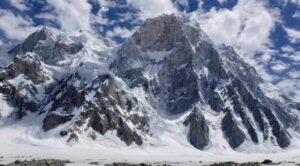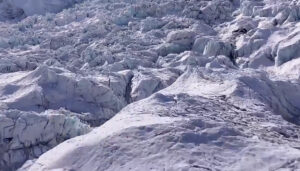Back in Base Camp, recent Everest climbers are finally posting their summit pictures — carefully cropping out anyone from other teams, as per Nepal’s oddball new rule. Also conspicuous by its absence is any view of the route itself, where dozens of climbers probably formed a line down the Hillary Step.
Today, about 50 climbers summited Everest, according to Nepali media. With yesterday’s nearly 100, this marks a busy start to the week. But the waves of summiters won’t last: The good weather might hold through tomorrow, but a westerly storm front has entered Nepal. Once settled in, it will envelop the mountains until May 20. Those who failed to surf this wave will have to wait at least a week.

Bahrain Royal Guard on the summit. Photo: Bahrain to Everest
Lower down, helicopters flit regularly up and down the valley, bringing oxygen canisters and removing COVID victims. About 19 people flew out yesterday, nine others two days ago.
In this case, ExWeb’s sources have chosen to remain anonymous, since everyone is under pressure to stay silent if they want climbing permits in the future. But voices are starting to speak, still in whispers, in Base Camp, in Kathmandu, and along the Khumbu Valley about an unsustainable situation.
No one is officially infected
Doctors at Everest Base Camp told The Nepali Times that so far, helicopters have evacuated about 30 people “with suspected Covid-19 symptoms.” That number is conservative, of course, and those evacuated are “suspects” because doctors are not permitted to run COVID tests on site. Everyone showing symptoms of COVID must go to the foreigners’ hospital in Kathmandu for tests and a final diagnosis. There too, the hospital doctors remain silent. So apart from the word of a couple of afflicted climbers, no one is officially infected.
After some quiet days which prompted hope that the rash of cases was tapering off, they have picked up again. One climber remarks that some teams strictly follow safety protocols, while others simply don’t care. They are reckless both in Base Camp and in their stays downvalley. As customary, several teams have retreated to Namche Bazaar, Pheriche, and other villages for some rest at lower altitudes before the final summit push. The consequences of their interactions in stores and lodges where COVID is spreading remain to be seen.

Nirmal Purja’s Elite team fraternizes with Jon Kedrowski and pop star Mike Posner. Hopefully, COVID was not in the picture. Photo: Nirmal Purja
The era of the aero-taxi
Helicopters have quickly become a big profit centre in the Everest business. They have replaced porters and yaks, they resupply up to Camp 2, they rescue, they airlift the sick, and they serve as aero-taxis for trips up and down the Khumbu or between Kathmandu and Base Camp. It is likely that they too spread the virus.
Part or all of the Bahraini team has already returned to Kathmandu. We don’t know whether they reached Base Camp under their own steam or whether they grabbed an aero-taxi from Camp 2. An Everest climb is only complete if the climber descends entirely down to Base Camp.
In Kathmandu, climbers go to the CIEWC Hospital, a private centre for foreigners. Unlike virtually all public hospitals in Nepal, they have enough beds, medical supplies, and oxygen.
At least, Nepal’s government has apparently reached an agreement to receive all the empty oxygen bottles from Base Camp, to refill and use at local hospitals.






